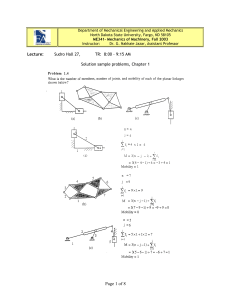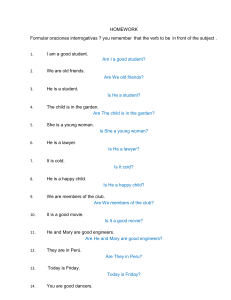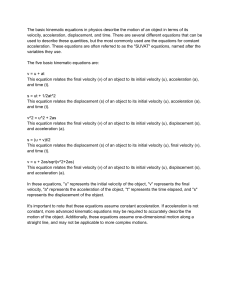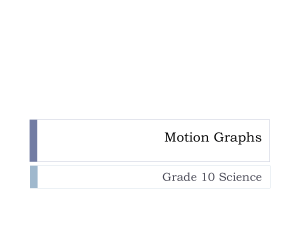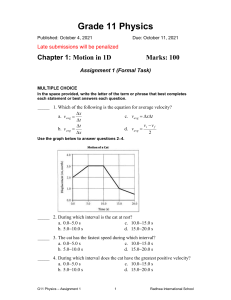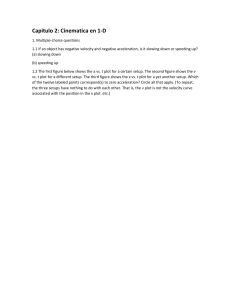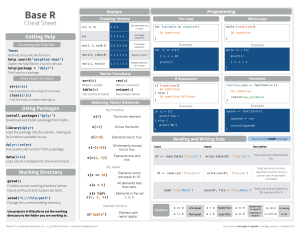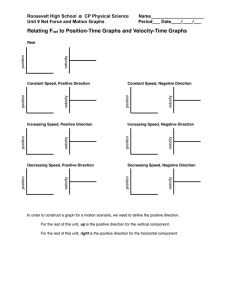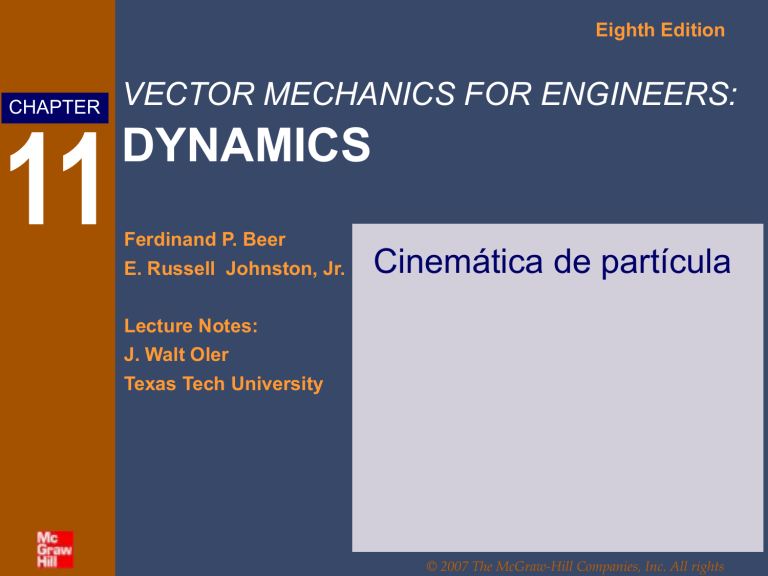
Eighth Edition CHAPTER 11 VECTOR MECHANICS FOR ENGINEERS: DYNAMICS Ferdinand P. Beer E. Russell Johnston, Jr. Cinemática de partícula Lecture Notes: J. Walt Oler Texas Tech University © 2007 The McGraw-Hill Companies, Inc. All rights Eight h Vector Mechanics for Engineers: Dynamics Contenidos Introducción Movimiento rectilineo: Posición, Velocidad & Acceleración Determinación del Movimiento de una Particula Sample Problema 11.2 Sample Problema 11.3 Movimiento rectilineo uniforme Movimiento rectilíneo uniformemente acelerado Movimiento de Several Particulas: Movimiento relativo Sample Problem 11.4 Movimiento de Several Particulas: Movimiento dependiente Sample Problem 11.5 Graphical Solution of Rectilinear-Motion Problems Other Graphical Methods Movimiento curvilineo : Posición, Velocida & Aceleración Derivada de Vector Función Componentes rectangular de Velocidad y Aceleración Movimiento Relativo de una Frame en Traslación Componentes tangencial y Normal Componentes radial y Transversal Sample Problem 11.10 Sample Problem 11.12 © 2007 The McGraw-Hill Companies, Inc. All rights 11 - 2 Eight h Vector Mechanics for Engineers: Dynamics Introduction • Dinámica incluye: - Cinemática: Estudio de la geometría del movimiento. Cinemática es usada para relacionar desplazamiento, velocidad, aceleración, y tiempo sin tener en cuenta la causa del movimiento. - Cinética: estudio de la relación existente entre la acción de la fuerza actuando en un cuerpo, la masa, y el movimiento del cuerpo. La cinética es usada para predecir el movimiento causada por fuerza dad o la determinación de la fuerza requerida para producir un movimiento dado. • Movimiento rectilíneo : posición, velocidad, y aceleración de a partícula a través de una línea recta. • Movimiento curvilíneo : Es la posición, velocidad, y aceleración de una partícula a lo largo de una línea curva en dos o tres dimensiones. © 2007 The McGraw-Hill Companies, Inc. All rights 11 - 3 Eight h Vector Mechanics for Engineers: Dynamics Movimiento rectilíneo : Posición, Velocidad & Acceleration • La partícula que se mueve a lo largo de una línea recta esta en movimiento rectilíneo. • La coordenada de Posición de una partícula esta definida por la distancia positiva o negativa de un origen fijo de la línea. • El movimiento de una partícula se conoce si se conoce la coordenada de una partícula con muchos valores de tiempo t. El movimiento de una partícula se puede expresar con la siguiente función. O en la forma de un gráfico x vs. t. © 2007 The McGraw-Hill Companies, Inc. All rights 11 - 4 Eight h Vector Mechanics for Engineers: Dynamics Rectilinear Motion: Position, Velocity & Acceleration • Considere la partícula que ocupa una posición P en un tiempo t y P’ como t+Δt, Velocidad promedio Velocidad instantánea • La velocidad instantánea puede ser positiva o negativa. La magnitud de la velocidad esta referida como rapidez de la partícula. • De la definición de una derivada, e.g., © 2007 The McGraw-Hill Companies, Inc. All rights 11 - 5 Eight h Vector Mechanics for Engineers: Dynamics Rectilinear Motion: Position, Velocity & Acceleration • Considere una partícula con velocidad v con un tiempo t y v’ como t+Δt, Aceleración instantanea • Instantaneous acceleration may be: - positive: increasing positive velocity or decreasing negative velocity - negative: decreasing positive velocity or increasing negative velocity. • From the definition of a derivative, © 2007 The McGraw-Hill Companies, Inc. All rights 11 - 6 Eight h Vector Mechanics for Engineers: Dynamics Rectilinear Motion: Position, Velocity & Acceleration • Consider particle with motion given by • at t = 0, x = 0, v = 0, a = 12 m/s2 • at t = 2 s, x = 16 m, v = vmax = 12 m/s, a = 0 • at t = 4 s, x = xmax = 32 m, v = 0, a = -12 m/s2 • at t = 6 s, x = 0, v = -36 m/s, a = 24 m/s2 © 2007 The McGraw-Hill Companies, Inc. All rights 11 - 7 Eight h Vector Mechanics for Engineers: Dynamics Determination of the Motion of a Particle • Recall, motion of a particle is known if position is known for all time t. • Typically, conditions of motion are specified by the type of acceleration experienced by the particle. Determination of velocity and position requires two successive integrations. • Three classes of motion may be defined for: - acceleration given as a function of time, a = f(t) - acceleration given as a function of position, a = f(x) - acceleration given as a function of velocity, a = f(v) © 2007 The McGraw-Hill Companies, Inc. All rights 11 - 8 Eight h Vector Mechanics for Engineers: Dynamics Determination of the Motion of a Particle • Acceleration given as a function of time, a = f(t): • Acceleration given as a function of position, a = f(x): © 2007 The McGraw-Hill Companies, Inc. All rights 11 - 9 Eight h Vector Mechanics for Engineers: Dynamics Determination of the Motion of a Particle • Acceleration given as a function of velocity, a = f(v): © 2007 The McGraw-Hill Companies, Inc. All rights 11 - 10 Eight h Vector Mechanics for Engineers: Dynamics Sample Problem 11.2 SOLUTION: • Integrate twice to find v(t) and y(t). • Solve for t at which velocity equals zero (time for maximum elevation) and evaluate corresponding altitude. Ball tossed with 10 m/s vertical velocity from window 20 m above ground. • Solve for t at which altitude equals zero (time for ground impact) and evaluate corresponding velocity. Determine: • velocity and elevation above ground at time t, • highest elevation reached by ball and corresponding time, and • time when ball will hit the ground and corresponding velocity. © 2007 The McGraw-Hill Companies, Inc. All rights 11 - 11 Eight h Vector Mechanics for Engineers: Dynamics Sample Problem 11.2 SOLUTION: • Integrate twice to find v(t) and y(t). © 2007 The McGraw-Hill Companies, Inc. All rights 11 - 12 Eight h Vector Mechanics for Engineers: Dynamics Sample Problem 11.2 • Solve for t at which velocity equals zero and evaluate corresponding altitude. • Solve for t at which altitude equals zero and evaluate corresponding velocity. © 2007 The McGraw-Hill Companies, Inc. All rights 11 - 13 Eight h Vector Mechanics for Engineers: Dynamics Sample Problem 11.2 • Solve for t at which altitude equals zero and evaluate corresponding velocity. © 2007 The McGraw-Hill Companies, Inc. All rights 11 - 14 Eight h Vector Mechanics for Engineers: Dynamics Sample Problem 11.3 SOLUTION: • Integrate a = dv/dt = -kv to find v(t). • Integrate v(t) = dx/dt to find x(t). Brake mechanism used to reduce gun recoil consists of piston attached to barrel moving in fixed cylinder filled with oil. As barrel recoils with initial velocity v0, piston moves and oil is forced through orifices in piston, causing piston and cylinder to decelerate at rate proportional to their velocity. • Integrate a = v dv/dx = -kv to find v(x). Determine v(t), x(t), and v(x). © 2007 The McGraw-Hill Companies, Inc. All rights 11 - 15 Eight h Vector Mechanics for Engineers: Dynamics Sample Problem 11.3 SOLUTION: • Integrate a = dv/dt = -kv to find v(t). • Integrate v(t) = dx/dt to find x(t). © 2007 The McGraw-Hill Companies, Inc. All rights 11 - 16 Eight h Vector Mechanics for Engineers: Dynamics Sample Problem 11.3 • Integrate a = v dv/dx = -kv to find v(x). • Alternatively, with and then © 2007 The McGraw-Hill Companies, Inc. All rights 11 - 17 Eight h Vector Mechanics for Engineers: Dynamics Movimiento uniforme Rectilíneo Para movimiento uniforme rectilíneo de una partícula, la aceleración es cero y la velocidad es constante. © 2007 The McGraw-Hill Companies, Inc. All rights 11 - 18 Eight h Vector Mechanics for Engineers: Dynamics Movimiento rectilíneo uniformemente acelerado Para movimiento rectilíneo uniformemente acelerado de una partícula, la aceleración de la partícula es constante. © 2007 The McGraw-Hill Companies, Inc. All rights 11 - 19 Eight h Vector Mechanics for Engineers: Dynamics Movimiento de un sistema de partícula. Movimiento relativo. • Para partículas moviéndose a lo largo de una misma línea, time should be recorded from the same starting instant and displacements should be measured from the same origin in the same direction. relative position of B with respect to A relative velocity of B with respect to A relative acceleration of B with respect to A © 2007 The McGraw-Hill Companies, Inc. All rights 11 - 20 Eight h Vector Mechanics for Engineers: Dynamics Sample Problem 11.4 SOLUTION: • Substitute initial position and velocity and constant acceleration of ball into general equations for uniformly accelerated rectilinear motion. • Substitute initial position and constant velocity of elevator into equation for uniform rectilinear motion. Ball thrown vertically from 12 m level in elevator shaft with initial velocity of 18 m/s. At same instant, open-platform elevator passes 5 m level moving upward at 2 m/s. Determine (a) when and where ball hits elevator and (b) relative velocity of ball and elevator at contact. © 2007 The McGraw-Hill Companies, Inc. All rights • Write equation for relative position of ball with respect to elevator and solve for zero relative position, i.e., impact. • Substitute impact time into equation for position of elevator and relative velocity of ball with respect to elevator. 11 - 21 Eight h Vector Mechanics for Engineers: Dynamics Sample Problem 11.4 SOLUTION: • Substitute initial position and velocity and constant acceleration of ball into general equations for uniformly accelerated rectilinear motion. • Substitute initial position and constant velocity of elevator into equation for uniform rectilinear motion. © 2007 The McGraw-Hill Companies, Inc. All rights 11 - 22 Eight h Vector Mechanics for Engineers: Dynamics Sample Problem 11.4 • Write equation for relative position of ball with respect to elevator and solve for zero relative position, i.e., impact. • Substitute impact time into equations for position of elevator and relative velocity of ball with respect to elevator. © 2007 The McGraw-Hill Companies, Inc. All rights 11 - 23 Eight h Vector Mechanics for Engineers: Dynamics Motion of Several Particles: Dependent Motion • Position of a particle may depend on position of one or more other particles. • Position of block B depends on position of block A. Since rope is of constant length, it follows that sum of lengths of segments must be constant. constant (one degree of freedom) • Positions of three blocks are dependent. constant (two degrees of freedom) • For linearly related positions, similar relations hold between velocities and accelerations. © 2007 The McGraw-Hill Companies, Inc. All rights 11 - 24 Eight h Vector Mechanics for Engineers: Dynamics Sample Problem 11.5 SOLUTION: • Define origin at upper horizontal surface with positive displacement downward. • Collar A has uniformly accelerated rectilinear motion. Solve for acceleration and time t to reach L. • Pulley D has uniform rectilinear motion. Calculate change of position at time t. Pulley D is attached to a collar which is pulled down at 3 in./s. At t = 0, • Block B motion is dependent on motions collar A starts moving down from K of collar A and pulley D. Write motion with constant acceleration and zero initial velocity. Knowing that velocity relationship and solve for change of block B position at time t. of collar A is 12 in./s as it passes L, determine the change in elevation, • Differentiate motion relation twice to velocity, and acceleration of block B develop equations for velocity and when block A is at L. acceleration of block B. © 2007 The McGraw-Hill Companies, Inc. All rights 11 - 25 Eight h Vector Mechanics for Engineers: Dynamics Sample Problem 11.5 SOLUTION: • Define origin at upper horizontal surface with positive displacement downward. • Collar A has uniformly accelerated rectilinear motion. Solve for acceleration and time t to reach L. © 2007 The McGraw-Hill Companies, Inc. All rights 11 - 26 Eight h Vector Mechanics for Engineers: Dynamics Sample Problem 11.5 • Pulley D has uniform rectilinear motion. Calculate change of position at time t. • Block B motion is dependent on motions of collar A and pulley D. Write motion relationship and solve for change of block B position at time t. Total length of cable remains constant, © 2007 The McGraw-Hill Companies, Inc. All rights 11 - 27 Eight h Vector Mechanics for Engineers: Dynamics Sample Problem 11.5 • Differentiate motion relation twice to develop equations for velocity and acceleration of block B. © 2007 The McGraw-Hill Companies, Inc. All rights 11 - 28 Eight h Vector Mechanics for Engineers: Dynamics Graphical Solution of Rectilinear-Motion Problems • Given the x-t curve, the v-t curve is equal to the x-t curve slope. • Given the v-t curve, the a-t curve is equal to the v-t curve slope. © 2007 The McGraw-Hill Companies, Inc. All rights 11 - 29 Eight h Vector Mechanics for Engineers: Dynamics Graphical Solution of Rectilinear-Motion Problems • Given the a-t curve, the change in velocity between t1 and t2 is equal to the area under the a-t curve between t1 and t2. • Given the v-t curve, the change in position between t1 and t2 is equal to the area under the v-t curve between t1 and t2. © 2007 The McGraw-Hill Companies, Inc. All rights 11 - 30 Eight h Vector Mechanics for Engineers: Dynamics Other Graphical Methods • Moment-area method to determine particle position at time t directly from the a-t curve: using dv = a dt , first moment of area under a-t curve with respect to t = t1 line. © 2007 The McGraw-Hill Companies, Inc. All rights 11 - 31 Eight h Vector Mechanics for Engineers: Dynamics Other Graphical Methods • Method to determine particle acceleration from v-x curve: subnormal to v-x curve © 2007 The McGraw-Hill Companies, Inc. All rights 11 - 32 Eight h Vector Mechanics for Engineers: Dynamics Curvilinear Motion: Position, Velocity & Acceleration • Particle moving along a curve other than a straight line is in curvilinear motion. • Position vector of a particle at time t is defined by a vector between origin O of a fixed reference frame and the position occupied by particle. • Consider particle which occupies position P defined by at time t and P’ defined by at t + Δt, instantaneous velocity (vector) instantaneous speed (scalar) © 2007 The McGraw-Hill Companies, Inc. All rights 11 - 33 Eight h Vector Mechanics for Engineers: Dynamics Curvilinear Motion: Position, Velocity & Acceleration • Consider velocity of particle at time t and velocity at t + Δt, instantaneous acceleration (vector) • In general, acceleration vector is not tangent to particle path and velocity vector. © 2007 The McGraw-Hill Companies, Inc. All rights 11 - 34 Eight h Vector Mechanics for Engineers: Dynamics Derivatives of Vector Functions • Let be a vector function of scalar variable u, • Derivative of vector sum, • Derivative of product of scalar and vector functions, • Derivative of scalar product and vector product, © 2007 The McGraw-Hill Companies, Inc. All rights 11 - 35 Eight h Vector Mechanics for Engineers: Dynamics Rectangular Components of Velocity & Acceleration • When position vector of particle P is given by its rectangular components, • Velocity vector, • Acceleration vector, © 2007 The McGraw-Hill Companies, Inc. All rights 11 - 36 Eight h Vector Mechanics for Engineers: Dynamics Rectangular Components of Velocity & Acceleration • Rectangular components particularly effective when component accelerations can be integrated independently, e.g., motion of a projectile, with initial conditions, Integrating twice yields • Motion in horizontal direction is uniform. • Motion in vertical direction is uniformly accelerated. • Motion of projectile could be replaced by two independent rectilinear motions. © 2007 The McGraw-Hill Companies, Inc. All rights 11 - 37 Eight h Vector Mechanics for Engineers: Dynamics Motion Relative to a Frame in Translation • Designate one frame as the fixed frame of reference. All other frames not rigidly attached to the fixed reference frame are moving frames of reference. • Position vectors for particles A and B with respect to the fixed frame of reference Oxyz are • Vector joining A and B defines the position of B with respect to the moving frame Ax’y’z’ and • Differentiating twice, velocity of B relative to A. acceleration of B relative to A. • Absolute motion of B can be obtained by combining motion of A with relative motion of B with respect to moving reference frame attached to A. © 2007 The McGraw-Hill Companies, Inc. All rights 11 - 38 Eight h Vector Mechanics for Engineers: Dynamics Componente normal y tangencial • El vector velocidad de una partícula es tangente a la trayectoria de la partícula. En general, no para el vector aceleración. El cual el vector aceleración se expresa en términos de componentes tangencial y normal. • son vectores unitarios tangencial de la partícula en la trayectoria de P y P’. Donde en el dibujo con respecto al mismo origen, Y © 2007 The McGraw-Hill Companies, Inc. All rights es el ángulo entre ambos. 11 - 39 Eight h Vector Mechanics for Engineers: Dynamics Componente normal y tangencial • Con el vector velocidad expresado como La aceleración de la particula puede ser escrita como pero Sustituyendo después • La componente tangencial de la aceleración refleja cambio de rapidez y la componente normal refleja cambio de dirección. • La componente tangencial puede ser posistivo o negativo. La componente normal siempre se dirige hacia el centro de curvatura de la trayectoria. © 2007 The McGraw-Hill Companies, Inc. All rights 11 - 40 Eight h Vector Mechanics for Engineers: Dynamics Componentes normal y tangencial • Las relaciones de las aceleraciones normal y tangencial también se aplican a partículas que se mueven a través del espacio. • En el plano contiene vectores unitarios tangencial y normal llamados planos osculador. • El plano osculador se fundamenta en • La aceleración no tiene componente a lo largo de la binormal. © 2007 The McGraw-Hill Companies, Inc. All rights 11 - 41 Eight h Vector Mechanics for Engineers: Dynamics Componente radial y transversal • Cuando la posición de la partícula esta dada en coordenadas polares, es conveniente expresar velocidad y aceleración en componentes paralelas y perpendiculares a OP. • El vector velocidad de la partícula es • Similarmente, el vector aceleración de la partícula es © 2007 The McGraw-Hill Companies, Inc. All rights 11 - 42 Eight h Vector Mechanics for Engineers: Dynamics Radial and Transverse Components • When particle position is given in cylindrical coordinates, it is convenient to express the velocity and acceleration vectors using the unit vectors • Position vector, • Velocity vector, • Acceleration vector, © 2007 The McGraw-Hill Companies, Inc. All rights 11 - 43 Eight h Vector Mechanics for Engineers: Dynamics Sample Problem 11.10 SOLUTION: • Calculate tangential and normal components of acceleration. • Determine acceleration magnitude and direction with respect to tangent to curve. A motorist is traveling on curved section of highway at 60 mph. The motorist applies brakes causing a constant deceleration rate. Knowing that after 8 s the speed has been reduced to 45 mph, determine the acceleration of the automobile immediately after the brakes are applied. © 2007 The McGraw-Hill Companies, Inc. All rights 11 - 44 Eight h Vector Mechanics for Engineers: Dynamics Sample Problem 11.10 SOLUTION: • Calculate tangential and normal components of acceleration. • Determine acceleration magnitude and direction with respect to tangent to curve. © 2007 The McGraw-Hill Companies, Inc. All rights 11 - 45 Eight h Vector Mechanics for Engineers: Dynamics Sample Problem 11.12 SOLUTION: • Evaluate time t for θ = 30o. • Evaluate radial and angular positions, and first and second derivatives at time t. Rotation of the arm about O is defined by θ = 0.15t2 where θ is in radians and t in seconds. Collar B slides along the arm such that r = 0.9 - 0.12t2 where r is in meters. • Calculate velocity and acceleration in cylindrical coordinates. • Evaluate acceleration with respect to arm. After the arm has rotated through 30o, determine (a) the total velocity of the collar, (b) the total acceleration of the collar, and (c) the relative acceleration of the collar with respect to the arm. © 2007 The McGraw-Hill Companies, Inc. All rights 11 - 46 Eight h Vector Mechanics for Engineers: Dynamics Sample Problem 11.12 SOLUTION: • Evaluate time t for θ = 30o. • Evaluate radial and angular positions, and first and second derivatives at time t. © 2007 The McGraw-Hill Companies, Inc. All rights 11 - 47 Eight h Vector Mechanics for Engineers: Dynamics Sample Problem 11.12 • Calculate velocity and acceleration. © 2007 The McGraw-Hill Companies, Inc. All rights 11 - 48 Eight h Vector Mechanics for Engineers: Dynamics Sample Problem 11.12 • Evaluate acceleration with respect to arm. Motion of collar with respect to arm is rectilinear and defined by coordinate r. © 2007 The McGraw-Hill Companies, Inc. All rights 11 - 49
